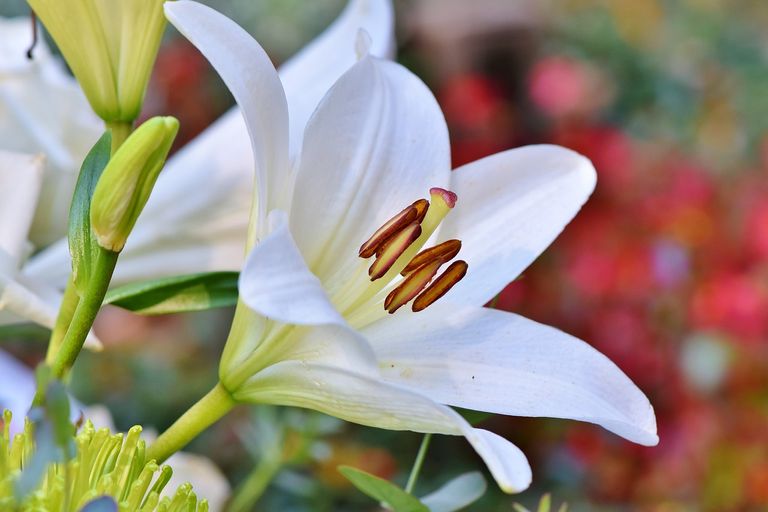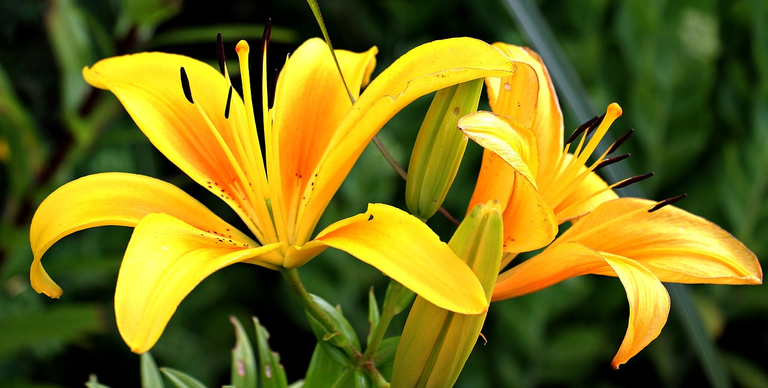
Si hablamos del lirio ahora es solo para anticipar su placer la próxima primavera. Habrá tiempo en el otoño para pasar del sueño a la realidad, decidir su compra, colocarlos donde sea bueno para ellos y hermoso para nosotros. Pero ya no es tan fácil tener un verdadero lirio de San Antonio, el muy blanco Lilium candidum.
O el Lìlium davidii, que florece un poco más tarde, en el mes de junio. Tanto es así que un refinado conocedor como Enrico Shejbal, de origen holandés, les ha dedicado una guía online para presentárselos a los aficionados (IIsentiero verde dei bulbi, www.floriana.ws). "Hay pocos lirios verdaderos, es decir, plantas bulbosas del género Lilium que se pueden plantar en otoño", escribe.
La planta.
El lirio, lilium, pertenece a la familia de las liliáceas, es originario de Siria y Palestina. Tiene hojas estrechas con nervaduras paralelas, dispuestas alrededor del tallo. Las flores están compuestas por seis pétalos, a menudo reunidos en numerosas inflorescencias sobre largos tallos, de diferentes colores que, según la especie, pueden resultar muy fragantes.
Casi todos holandeses, son los maestros. En cambio, para el verdadero lirio, ya en octubre puede comenzar a cavar un hoyo que deje, en profundidad, unos tres centímetros de tierra para cubrir el bulbo. Considerando en cambio un espacio horizontal libre entre uno y otro, si se quiere que sea numeroso, que sea el doble del diámetro de la bombilla.
Las variedades.
Antes de elegir cualquier variedad de lirio, lee la tarjeta / etiqueta de la planta para poder comprar una variedad resistente resistente al frío invernal, de lo contrario terminaremos comprando un lirio que solo puede prosperar en el corto espacio de la temporada de verano. Hay variedades moteadas, resistentes al frío o al calor. Por ejemplo, los lirios asiáticos temen el gran calor y deben protegerse en el verano; por el contrario, muchas especies temen el frío y deben enterrarse más profundamente si se cultivan en el norte (o se desentierran en otoño y se plantan en la primavera siguiente).
El lirio de San Antonio.
El lirio blanco, también llamado lirio de Sant'Antonio, es sin duda el más conocido. Su nombre botánico es Lilium candidum. Es la planta ligada a la iconografía cristiana y bastante resistente: es capaz de prosperar en suelos pedregosos, al costado de la carretera y en suelos ricos en escombros.
Es sensible al moho, por lo que odia la alta humedad y el estancamiento del agua. Su altura es variable (desde 150 cm hasta más de 2 metros) y, en verano, ofrece una floración muy rica. Para toda la información sobre su significado, su cultivo y las necesidades culturales a respetar, te invitamos a visitar la página Cómo cultivar el lirio blanco.
El lirio de San Giuseppe.
El lirio de San José o Lilium bulbiferum es un bulbo muy extendido en Europa central. Se puede cultivar en el norte de Italia porque es más resistente al frío. Prefiere suelos calcáreos y lugares soleados. La flor es de color naranja y varía de tonos más claros a más pesados. Los puntos también varían y cambian de naranja a negro.
El lirio de Martagone.
El lirio de martagon florece en las laderas soleadas entre los arbustos. Crece en suelos calcáreos, neutros o ligeramente ácidos, prospera espontáneamente en los Alpes y los Apeninos: está claro que es un lirio resistente al frío. Florece en verano y tiene pétalos moteados más oscuros. Los pétalos miran hacia abajo y a veces incluso tocan el tallo. El color de fondo de los lirios martagon es un rosa muy vivo y tiene motas más oscuras.
Lirios de doble flor.
Los lirios de doble flor sorprenden con una floración aún más predominante, destacando las variedades Lilium Dot Com y Lilium Fenice. Los lirios de doble flor tienen corolas mucho más voluminosas que, en lugar de los clásicos seis pétalos, llevan corolas con 12, 18 o incluso 24 elementos. Las variedades de flores dobles se clasifican como lirios modernos porque no contienen polen ni fragancias. Otra variedad de doble flor es el lirio oriental Roselily. Los lirios modernos se han seleccionado para proporcionar flores más grandes y vistosas y para superar dos problemas clásicos de los lirios: manchas de polen y un perfume demasiado fuerte.

If we talk about the lily now is only to anticipate their pleasure next spring. There will be time in the fall to move from dream to reality, decide on their purchase, place them where it will be good for them and beautiful for us. But it is no longer so easy to have a real St. Anthony's lily, the very white Lilium candidum.
Or the Lìlium davidii, which blooms a little later, in the month of June. So much so that a refined connoisseur like Enrico Shejbal, of Dutch origin, has dedicated an online guide to introduce them to amateurs (IIsentiero verde dei bulbi, www.floriana.ws). "There are few true lilies, i.e. bulbous plants of the genus Lilium that can be planted in autumn," he writes.
The plant.
The lily, lilium, belongs to the lily family, is native to Syria and Palestine. It has narrow leaves with parallel veins, arranged around the stem. The flowers are composed of six petals, often gathered in numerous inflorescences on long stems, of different colors that, depending on the species, can be very fragrant.
Almost all Dutch, they are the masters. For the true lily, on the other hand, as early as October you can start digging a hole that leaves, in depth, about three centimeters of soil to cover the bulb. Considering instead a free horizontal space between one and the other, if you want it to be numerous, that is twice the diameter of the bulb.
The varieties.
Before choosing any variety of lily, read the card / label of the plant to be able to buy a variety resistant to winter cold, otherwise we will end up buying a lily that can only thrive in the short space of the summer season. There are spotted, cold hardy or heat hardy varieties. For example, Asiatic lilies fear high heat and must be protected in the summer; conversely, many species fear cold and must be buried deeper if grown in the north (or dug up in the fall and planted the following spring).
St. Anthony's lily.
The white lily, also called Sant'Antonio lily, is undoubtedly the best known. Its botanical name is Lilium candidum. It is the plant linked to Christian iconography and quite hardy: it is able to thrive in stony soils, roadside and debris-rich soils.
It is sensitive to mildew, so it hates high humidity and water stagnation. Its height is variable (from 150 cm to more than 2 meters) and, in summer, it offers a very rich flowering. For all the information about its meaning, its cultivation and the cultural needs to respect, we invite you to visit the page How to grow the white lily.
####The San Giuseppe lily.
The St. Joseph lily or Lilium bulbiferum is a bulb widespread in central Europe. It can be grown in northern Italy because it is more resistant to cold. It prefers calcareous soils and sunny places. The flower is orange and varies from lighter to heavier shades. The dots also vary and change from orange to black.
Martagone lily.
Martagon lily blooms on sunny slopes among shrubs. It grows in calcareous, neutral or slightly acid soils, thrives spontaneously in the Alps and the Apennines: it is clearly a cold-resistant lily. It flowers in summer and has darker mottled petals. The petals face downwards and sometimes even touch the stem. The background color of martagon lilies is a very vivid pink and has darker speckles.
Double-flowered lilies.
Double-flowered lilies surprise with an even more predominant bloom, highlighting the Lilium Dot Com and Lilium Fenice varieties. Double-flowered lilies have much more voluminous corollas that, instead of the classic six petals, bear corollas with 12, 18 or even 24 elements. Double-flowered varieties are classified as modern lilies because they do not contain pollen or fragrance. Another double-flowered variety is the Oriental Roselily lily. Modern lilies have been selected to provide larger, showier flowers and to overcome two classic lily problems: pollen staining and overly strong perfume.
Traducida con / Translated with www.DeepL.com/Translator (free version)

Fuente imagen inicial / Source initial image: Pixabay -Ralphs_Fotos-
Fuente imagen final / Source final image: Pixabay -NoName_13-